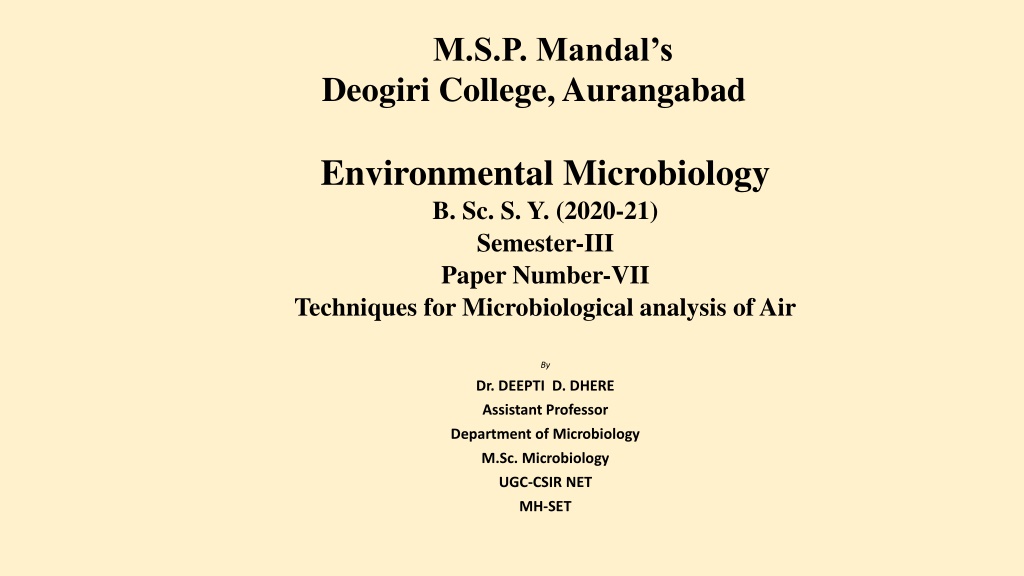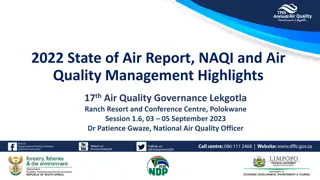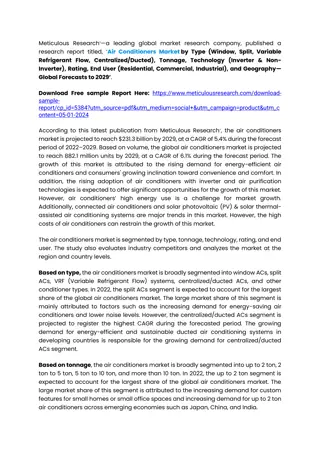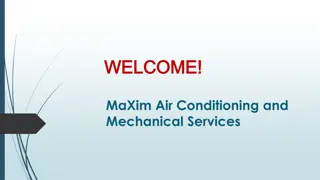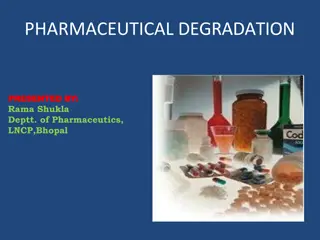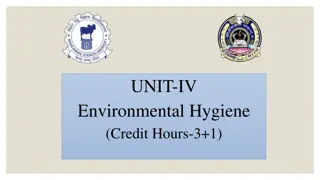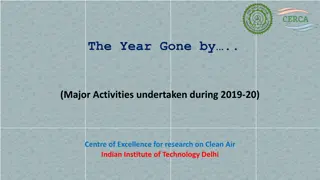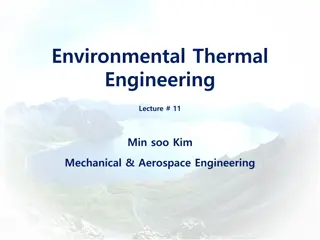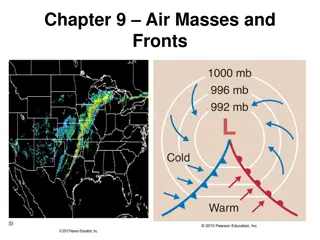Techniques for Microbiological Analysis of Air
Enumeration in microbiology involves determining the number of viable microbes in a sample, particularly in air analysis. Biological contaminants suspended in air, known as aerosols, vary in size and composition, with methods like impingement in liquid and impaction on solids used for enumeration. Different aerosol samplers utilize methods such as filtration, sedimentation, centrifugation, and electrostatic precipitation to collect and analyze microorganisms present in the air.
Download Presentation

Please find below an Image/Link to download the presentation.
The content on the website is provided AS IS for your information and personal use only. It may not be sold, licensed, or shared on other websites without obtaining consent from the author.If you encounter any issues during the download, it is possible that the publisher has removed the file from their server.
You are allowed to download the files provided on this website for personal or commercial use, subject to the condition that they are used lawfully. All files are the property of their respective owners.
The content on the website is provided AS IS for your information and personal use only. It may not be sold, licensed, or shared on other websites without obtaining consent from the author.
E N D
Presentation Transcript
M.S.P. Mandals Deogiri College, Aurangabad Environmental Microbiology B. Sc. S. Y. (2020-21) Semester-III Paper Number-VII Techniques for Microbiological analysis of Air By Dr. DEEPTI D. DHERE Assistant Professor Department of Microbiology M.Sc. Microbiology UGC-CSIR NET MH-SET
What is Enumeration? Enumeration in microbiology is the determination of the number of individual viable microbes in a sample. There are several methods, which require special devices, designed for the enumeration of microorganisms in air. However, none of these devices collects and counts all the microorganisms in the air sample tested. Some microbial cells are destroyed and some entirely pass through in all the processes. The most important ones are- 1. Solid and liquid impingement devices, 2. Filtration, 3. Sedimentation, 4. Centrifugation, 5. Electrostatic precipitation
Biological Contaminants suspended are called as aerosols. Each particle of air may vary in size from less than 1 to 50 or more. The suspended particle may contains one or more microorganisms but as the environmental parameters are not suitable for growth and multiplication they can not grow and multiply. Therefore most of the microorganisms present in the air are resistant form of the microorganisms e.g. spores Many kinds of bacterial species such as Staphylococci, Streptococci and Mycobacterium resist drying. They can survive for longer period of time and carried to a longer distance by air current. If they settle in the quite atmosphere, they may become again air born with air current or human activities like sweeping, bed making etc. can be
Enumeration Methods There are several methods for enumeration of microorganisms in air. However, none of the methods collects and all the microorganisms in the air sample tested. Some microbial cells are destroyed and some entirely passed through in all the process. On the basis of modes of action aerosol samplers are classified as- 1. Impingement in liquid 2. Impaction on solids, 3. Filtration 4. Sedimentation 5. Centrifugation 6. Electrostatic precipitation 7. Thermal precipitations
Impingement in liquid In this method, air is drawn through a very small opening or a capillary tube and bubbled through a liquid . The organisms suspended in air pass through a capillary tube and trapped in the liquid medium during bubbling process. The aliquots of the liquid are then plated on nutrient media to determine its microbial content.
Impaction on solids In this method suspended particles or microorganisms are directly dispersed on solid surface of agar medium. The agar medium is then incubated until visible colonies appear on the solid medium. Then colonies are counted and taken as microbial count present in the air There are several devices used to perform this techniques. But Settling plate techniques is the simplest and most popular method. The limitation of this technique is that, it does not record the amount of air sampled It only gives the information about the kinds of microorganisms present in that particular environment/area. There are some devices which are designed so that it can measure the volume of air sampled. These are sieve and slit type of devices.
The sieve device have a large number of small pores in a metal cover. Under this metal cover there is a place to place a petri plate containing, the measured amount of air is drawn through the sieve, the air particles are impacted on the agar surface medium during this process. Then plate is removed aseptically from the sampler and incubated and colonies are observed after incubation. In slit device, the air is drawn through a very narrow slit into a petridish containing agar medium. The slit is approximately the length of the petridish. The petridish is kept at particular speed under slit and one complete turn is made during the sampling.
Sedimentation Air born microorganisms may be enumerated by exposing agar plate for different period of time. It is used to collect settle able particulate that settle out of the atmosphere as a result of the gravitational force. Particulate matter having size 10 m can be collected with 99% efficiency. Then the lids of the petri-plates replaced on it and all petri-plates under the study are incubated for different period of time. The colonies developed on agar surface after the incubation are counted. This is one of the simplest method used for enumeration of air micro-flora but it is of no value from quantitative stand point. It does not enumerate the no. of microorganisms in given volume of the air. However this method gives the relative results about quality of air. The air movement may influence the result by causing the deposition of the large sized particles. It can create the error in the results.
Though In this method only the rate of deposition of large particles from the air, not the total number of bacteria carrying particles per volume, is measured. Growth of bacteria in the settled particles may be affected by the medium used since not all microorganisms are growing well on all media. Moreover since air currents and any temporary disturbances in the sampling area can affect the count, many plates have to be used. Since only particles of certain dimensions tend to settle on to the agar surface and, also, the volume of air entering inside the Petri dish is not known, this technique gives only a rough estimate and can be used only to isolate air-borne microorganisms. However, one can gather information about the kind of air-borne microbes occurring in a particular area by repeated use of settling plate technique for a fixed period of time. the method has the advantage of simplicity, it has certain limits.
Filtration Polypore and Millipore membrane filters are used. If the diameter of the collected particles are larger than the pores of the membrane then all such particles are retained on the membrane filter. After filtration the membrane is agitated in suitable liquid to disperse the particles. The measured amount of that suspension are mixed with the molten cooled agar for pore plate technique and then incubated. After incubation the count of the air micro flora is determined. Here, the membrane filter can be directly placed on agar medium to get colonies after incubation.
Centrifugation In this method the centrifugal force is used to deposit air particles (microorganisms) on the collecting surface (medium) when air moves in a circular direction of high speed, the suspended aerosols are impacted on the collecting surface by a force proportion to the particle velocity and mass. In one type of centrifuge the sampler remains stationary while the aerosols travel in the circular path the large particles being collected at the bottom. In another type the collecting vessel and aerosols rotate at high velocity resulting in the impaction of particles on the wall
Electrostatic Precipitation In this method, air particles are collected by drawing air over an electrically charged surface. Two petriplates are hold in separate plastic unit with removable cover. A small electrically operated blower draws air at equal rates through the two units, one unit has the lower electrode negative and the upper electrode is positive in the other unit, the electrical conditions are reversed Both positively and negatively charged organisms exist in the air, simultaneously. Those having a positive charged are collect or the petridish placed over the negative electrodes while those negatively charged are collected on the petridish placed over the positive electrode
Thermal Precipitation In this method, air particles are collected on the surface by means of thermal gradient . Airborne particles are repelled by hot surfaces and deposited on the colder surface by force proportional to the temperature gradient. This method requires careful adjustment and the air sampling rank are quite low. They are not commonly used.
